Mercedes eVito electric van review (2023)
Likeable Mercedes electric van, boosted by improved range
PROS
- Low running costs
- No reduction in load area
- Now available with fast charging
- Good driving experience
- Not outrageously expensive
CONS
- Short driving range per charge
- Rivals go further for less money
- Bigger battery reduces payload
- Usual Vito cab and kit issues
Summary
The Mercedes-Benz eVito was the first full production 100% electric van from Mercedes to go on sale in the UK. It was also the first medium-sized electric van of any kind to become available here. It swiftly lagged behind rivals in terms of payload and range but the 2023 model has a much-needed bigger battery, which has addressed at least the latter of these.
The range now sits at a much more competitive 162 miles, which is a huge improvement on the 92 miles that it offered before. There are other bonuses as a result of the 2022 additions, with better charging and added trim levels.
Does this make the eVito an electric van worth considering now? Read on to find out...
What is the Mercedes eVito?
Based on the front-wheel drive version of the standard Mercedes-Benz Vito, the eVito replaces the diesel engine with an 85kW electric motor – equivalent to a modest 115hp – powered by battery packs mounted below the load floor.
This means it produces zero emissions in motion, making it suitable for ultra-low emissions zones and exempt from the London Congestion Charge, without any reduction in load space.
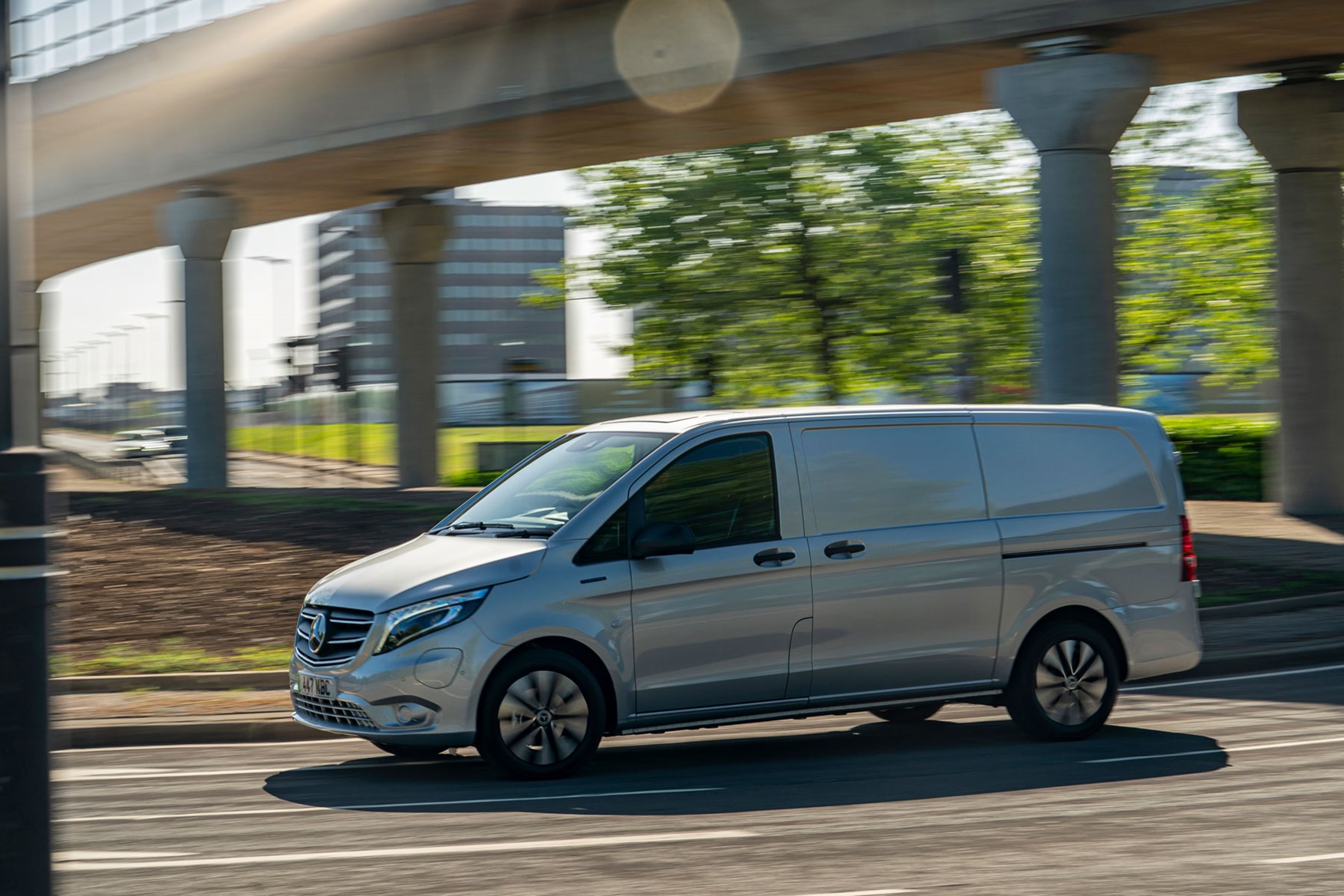
With a single-speed transmission it’s as straightforward to drive as any van with an automatic gearbox, while an improved torque rating of 360Nm means it’s able to get a full load moving very easily – and even feels rather nippy at low speeds around town, which is where it works best.
Many of the bad elements have been addressed with the new big battery, which extends the range and adds fast charging. It is far from perfect, though, as a bigger battery means the payload takes a hit so rivals are now even more practical.
2022 updates to the eVito
Mercedes has been updating the eVito on a regular basis since it first arrived in the UK. Updates to the standard van swiftly made it over to the electric version, while 2022 brought about a few other updates alongside the new battery.
These are largely additions to the specification, with a new Premium trim line and more safety equipment than before.
What’s the driving range of the eVito?
The range was one of the major reasons why the eVito wasn't worth considering versus much more competent rivals, but the 2022 update makes it a much more enticing prospect as it can now go 162 miles between charges. If you are buying a used one then look out for the early models, as they only offered an official range of 92 miles, and in reality it could have been less depending on your driving needs.

How much can the eVito carry?
The eVito comes in two sizes – L2 and L3, also known as Long and Extra-Long – and a single roof height. Both have a hefty 3,200kg (3.2-tonne) gross vehicle weight. This initially gave a 923kg payload for the L2 model and 898kg payload for the L3, but this dropped progressively with the various updates.
Full load area info can be found on our dedicated Mercedes-Benz eVito dimensions page.
How does it compare with rivals?
While Mercedes was first to market with an all-electric medium van in the UK, there are now several rivals - all of which deserve a closer look, as they challenge the eVito in different ways.
The Citroen e-Dispatch, Peugeot e-Expert and Vauxhall Vivaro-e – which are all versions of the same electric van – are a much more serious headache for Mercedes. Not only are they offered with a choice of battery sizes including the option for over 200 miles of driving range, they can also carry up to 1,275kg. And the pricing is cheaper than the Mercedes as well.
The Toyota Proace Electric is the same van again, but comes with the added benefit of a warranty that lasts for up to 10 years, which gives added peace of mind.
There's also the lesser-known Maxus eDeliver 3, although this doesn't offer quite the same practicality.
Want a green image with some pure-electric capability but the flexibility to travel longer distances without worrying about charging times? Then there’s the Ford Transit Custom Plug-in Hybrid and LEVC VN5 to consider as well.
Verdict: is the Mercedes-Benz eVito any good?
The verdict for the first versions of the eVito were full of caveats, all centred around how you would have to adapt your working life to the relatively low range and long charging times.
These caveats haven't totally gone - there is still an element of adapting needed to live with any electric van - but the eVito is at least now closer to its rivals rather than lagging behind on its own. It might not have quite the same range as some, and its pricing looks punchy, but it is at least on the same page now.
Skip to our full verdict on...
- Driving range easy to make the most of
- Simple to drive - like a Vito auto
- Several tricks to make the most of the batteries
The eVito electric van is not very different to drive to a regular diesel Vito with an automatic transmission. You get in, turn it on, select Drive using the usual Mercedes column-shifter that is mounted to the right of the steering wheel, disengage the foot-operated parking brake using a lever tucked down to your right, and then go. It has only a single-speed transmission, though, so there are no conventional gears at all.
Plus, due to the way the electric motor can function to slow the van as well as drive it forward, there are four different braking modes to get your head around. Fortunately, this isn’t as complex as it first sounds, and worth doing if you want to maximise the driving range.
What’s the eVito like to drive?
Like several other electric vans, the eVito does not offer the silent driving experience that often comes with battery-powered motoring. Some of this is as a result of an empty loading bay and is common to any van, but there is also a fair bit of road noise and humming from the motor.
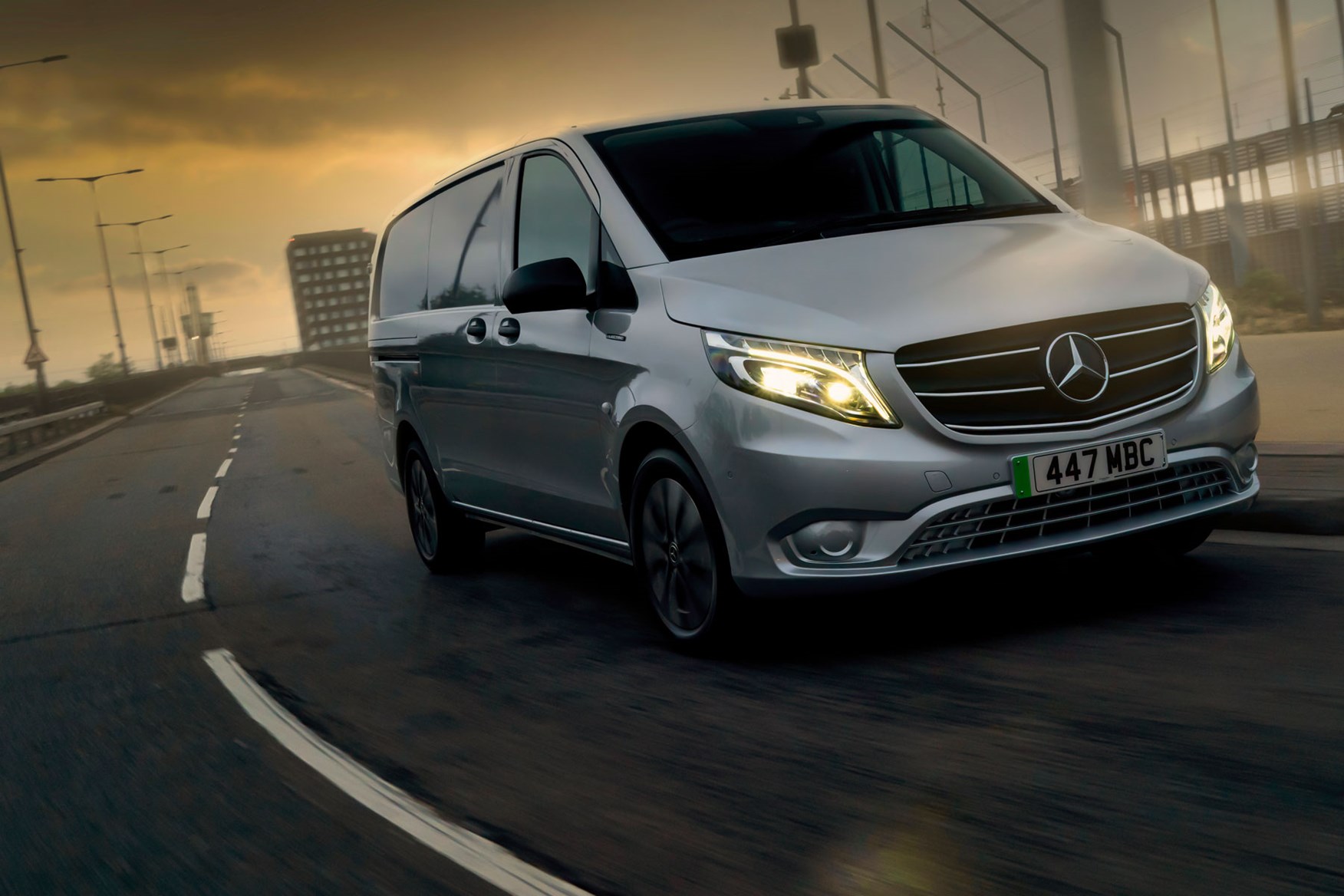
This aside, the eVito is very pleasant. The electric motor gives you all of its 360Nm of torque straight away which means it picks up from a standstill and low speeds very quickly. It has been detuned, though, to save both tyres and the contents of the loading bay - the former from wear the latter from being thrown around. It's progressive rather than a sudden surge of speed.
Unlike some small vans the eVito also happily makes its way up to motorway speeds, although it does feel a little strained when sitting at 70pmh - if you are travelling at pace then something around 50-60mph is a little more relaxed. The driving range will fall faster if you use full throttle everywhere, but there are three driving modes (in addition to the braking modes) that can help you manage this.
Steering, and stopping using the regular brake pedal, feels just as composed and comfortable as an ordinary Vito. The brakes are perhaps a little spongy, but suited to the sort of low-speed driving that the van will do the majority of the time. The ride seems firm initially, but it actually deals with bad road surfaces better than any direct electric van rival, and there’s not much lean in the corners, either.
What's more, the batteries under the floor boost the sensation of stability by lowering the van’s centre of gravity, which means you can really press on when driving on country lanes - assuming you've got plenty of battery to spare, anyway.
What are the eVito’s driving modes?
The driving modes are controlled by an unassuming looking button on the dashboard, which would usually control the response of the automatic transmission.
The three modes are E (Economy), E+ (Economy Plus) and C (Comfort), and they moderate accelerator response and motor power output, as well as dialling back the air-conditioning to help make the batteries last longer. The van starts in E, and we were happy to use this most of the time – only resorting to Comfort whenever we needed a little more oomph.
Driving predictable journey lengths, we have never really felt the need to activate E+. But the van remains perfectly useable in this setting (just a little lazier), and we can see how it might be useful if you’re worried about running out of charge on the way back home.
Understanding the braking modes
Like many electric vehicles now, the braking modes are controlled by paddleshifters on the steering wheel.
When you start it, the default is D- mode. This is the most efficient setting, with maximum motor braking recuperation of -1.5 metres per second, meaning that you hardly need to touch the brake pedal when driving around town. Simply lifting off the accelerator slows the van as the electric motor becomes a generator to recover energy back into the batteries. It won't stop you totally, though, so you will need to intervene when you get closer to a junction or similar.
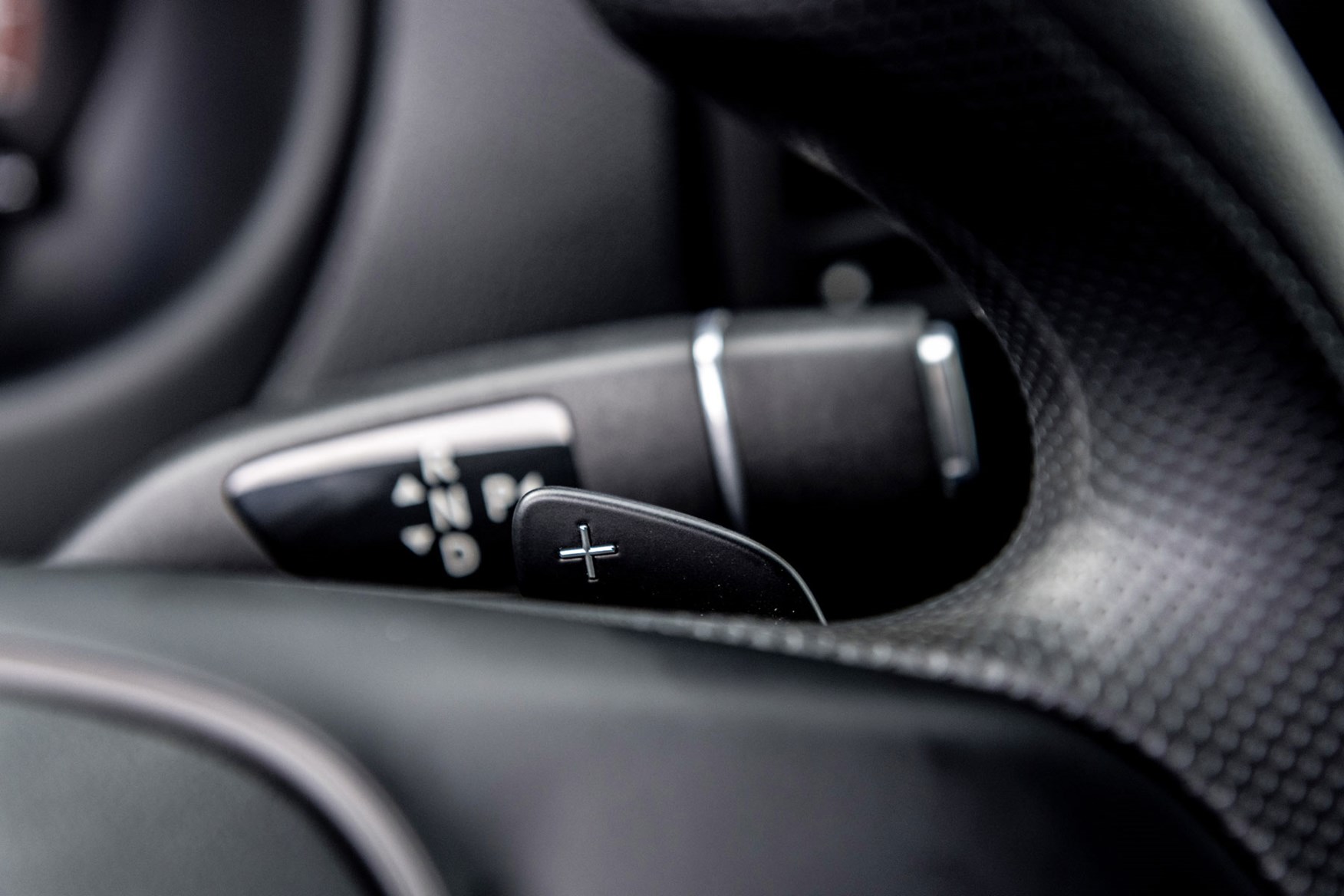
That might sound weird but it soon feels perfectly normal. Pull what would ordinarily be the change-up paddle on the steering wheel, and it switches you to D mode, with moderate braking-energy recuperation of -1.0ms, while another flick up to D+ reduces it to -0.5m/s.
A final change to D++ gives you no braking recuperation at all, meaning that the eVito will continue to roll along unchecked when you lift off the accelerator. You might wonder why you’d ever want to not recover energy back into the battery, but letting the van just roll on – also known as coasting or sailing – can be smoother and more efficient at motorway speeds. Equally, adding in more regeneration means the motor has to work harder to build speed back up more often
What’s the real-world driving range like?
Using the WLTP standard, Mercedes claims the eVito will cover 162 miles per charge. We've found this to be pretty accurate, and had no qualms about setting off for a long-distance drive in fair weather. That said, this will vary with the weather and the specification of the van. In winter, for example, you'll find the range perhaps significantly lower - but this is the same for all electric vehicles.
This is now less of a concern than it was when the range was so much lower - a 10-mile drop for putting on the heater and radio is not so much of a concern when you start with a fresh 160-odd miles in the battery.
While we never had occasion to run the battery right the way down, at no point have we found ourselves worried that the van might leave us stranded, even when driving faster and for longer distances.
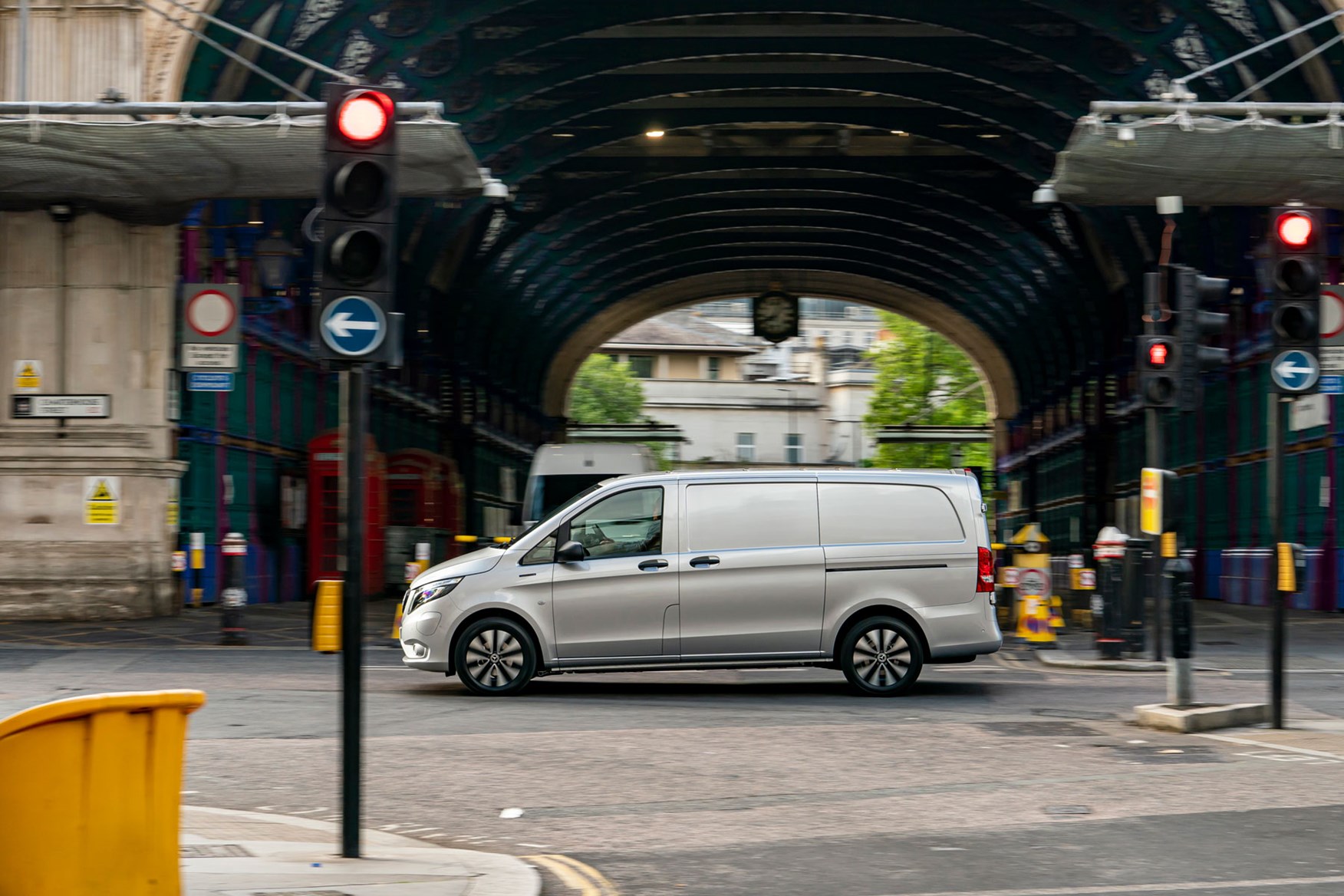
Basically, we have no reason to doubt the accuracy of the official range prediction, and that remains true with the most recent updates. The remaining range is shown on the display in the instrument cluster, and it doesn’t jump about in the same way it can in other electric vans. One way to reduce the impact of the heater is to make the most of the pre-conditioning function, which will heat or cool the cab while the van is plugged in to charge.
This is controlled via the Mercedes Me smartphone app, rather than anything inside the van. Not a major problem, but perhaps slightly inconvenient under some circumstances, such as when a lot of different drivers need to use the vehicle. Better get friendly with the fleet manager if you have a preferred cabin temperature in those circumstances...
- Little different to any other Vito inside
- Which means the cab is a little cramped
- And some of the controls take some getting used to
The interior is largely the same as a regular Vito, with the exception of some minor changes to the instrument cluster. So if you’re after an electric van that gives you a very routine driver and passenger experience the eVito should suit you just fine.
Small cab, confusing controls
Shame, then, that the Vito’s cab isn’t the most inviting place to spend time. Build quality is solid enough, but it’s not especially practical and the low roof can make it feel a bit cramped inside. The various updates have helped bring the feeling of quality up a few notches, with the seven-inch touchscreen a real step up over what early eVitos came with.
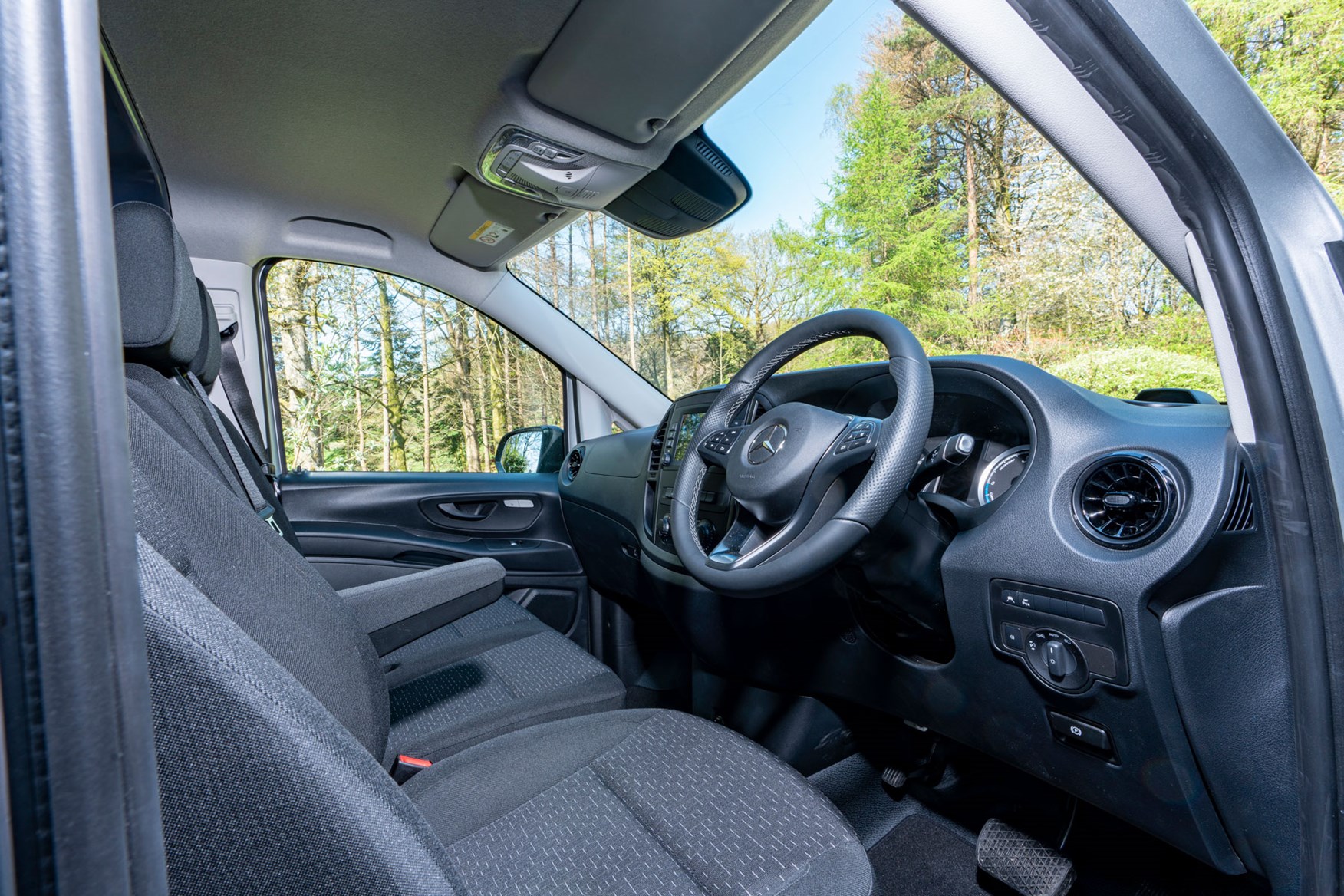
Mercedes’ slightly unconventional controls are all present. The key slot – more of an electronic docking process than a conventional key, as in all Vitos – is on the left of the steering wheel, and you select drive and reverse via a steering-column-mounted lever that’s positioned where every other van maker puts the windscreen wiper stalk.
If you jump into this fresh and it starts raining, do not be at all surprised if you knock it into neutral instead of turning the wipers on; the wiper controls are actually located on the indicator stalk.
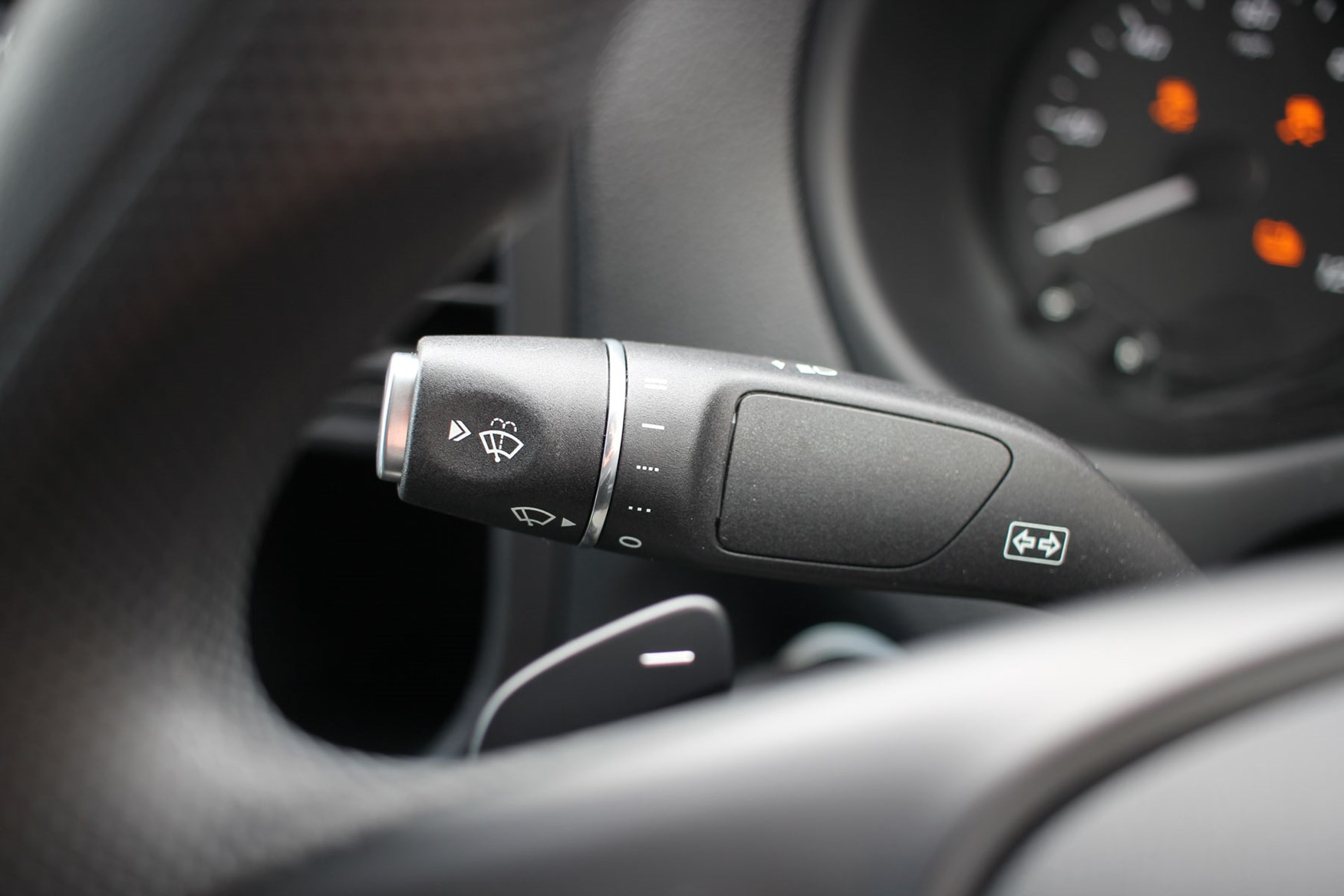
Then there’s the foot-operated parking brake, which is released via a pull-handle on the dashboard. Fine once you’re used to it, but certainly not a conventional set-up by other van standards, and something else for drivers to deal with if they’re regularly hopping between different vans - it's highly likely plenty will get in and have to hunt around for both the pedal and the release handle on their first encounter with the eVito.
Poor infotainment initially
The Vito has long struggled to be competitive when it comes to basic creature comforts like a radio, and the eVito was no exception at launch. The standard Audio 10 (entry-level Pure models) and Audio 15 infotainment systems (higher-spec Progressive models) were pretty basic. They don’t even have DAB.
But worse, one of the test vans we've sampled had the ‘upgraded’ Audio 40 infotainment system, which looks cheap and is unnecessarily confusing to use – like a poor-quality aftermarket system. It was the only way to get DAB, Apple CarPlay, Android Auto and sat-nav in the original eVito specification, unfortunately.
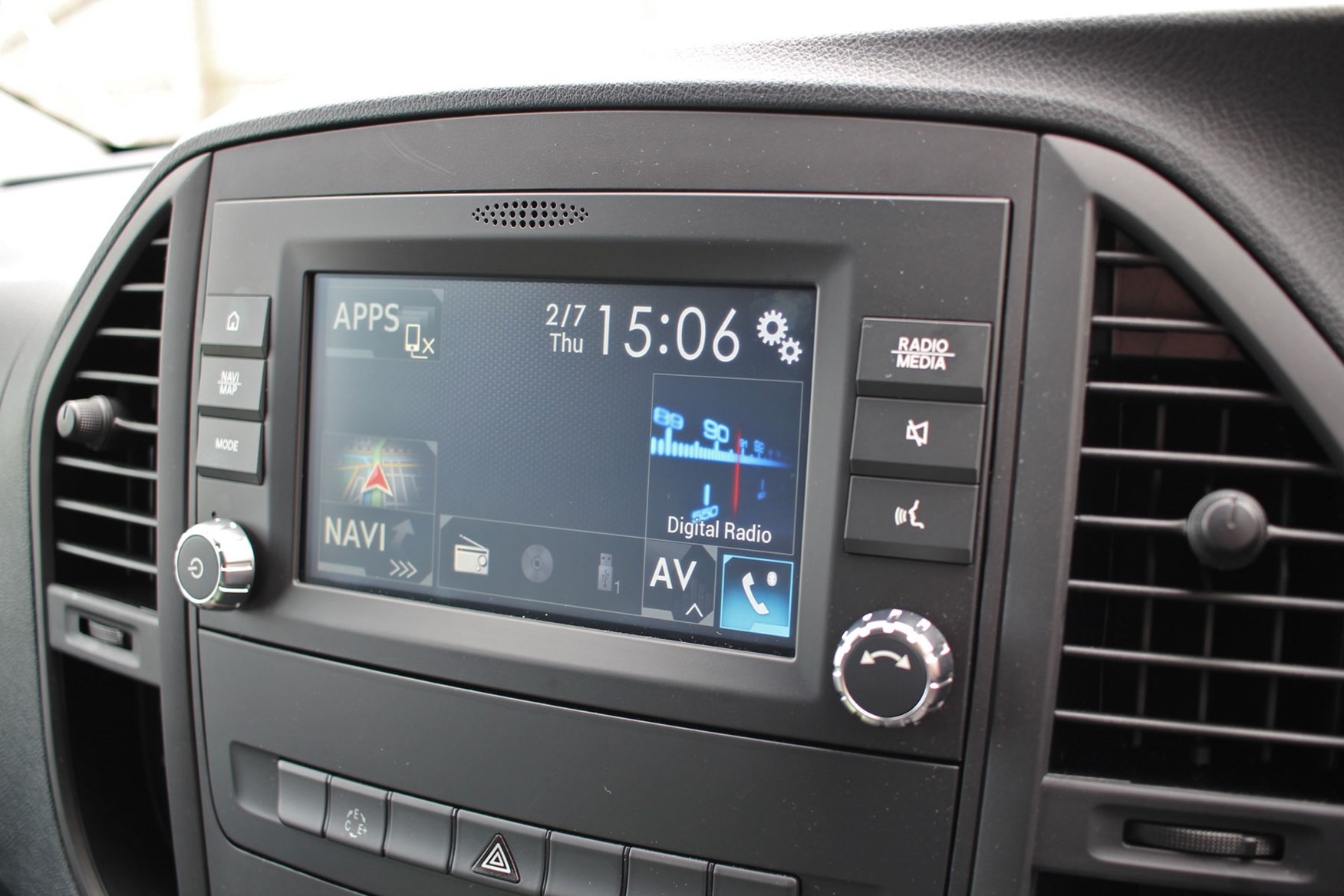
However, following upgrades in November 2020, which saw the trim levels change to Progressive and Plus Package (Pure being discontinued), the standard infotainment is now called the Audio 30.
As of 2022, all models come with a seven-inch touchscreen that brings all the smartphone mirroring functions that you would hope for in a van that costs this much. It is still a relatively small screen, and not as slick as many other systems that you can get these days, but it is streets ahead of what went before.
- Low day-to-day running costs
- Cheaper servicing
- Missing some key items of standard equipment
While electric vans are more expensive to buy than equivalent diesel vans, they are cheaper to run and cheaper to service.
How much does it cost to charge the Mercedes eVito?
Charging costs for the eVito are going to vary with your electricity tariff or the type of public charger you are able to use.
As the eVito now comes with the ability to use a fast charger, it is now possible to hook it up to the public posts that will cost you vast amounts for half a battery's worth. This isn't obligatory, of course, but it is something to bear in mind when drivers head out and feel they want to pop a few extra miles onto the range at lunch.
On the plus side, charging is a lot quicker, so you will regain work time by using a fast charger - you can get back 80% of the range in just 35 minutes. Using an 11kWh wallbox will take six and half hours to get a full charge, while a three-pin plug will take 20 hours.
Are electric vans cheap to tax?
Electric vans are currently cheap to tax – there are no road tax (VED) or company car tax (benefit-in-kind or BiK) charges.
Plus the eVito is exempt from the London Congestion Charge, and should be allowed to enter other low and ultra-low emissions zones (ULEZ) that may start springing up around the UK without cost.
Mercedes-Benz eVito servicing
Servicing should be cheaper – and is cheaper, according to Mercedes – because there are fewer moving parts and fewer fluids to change.
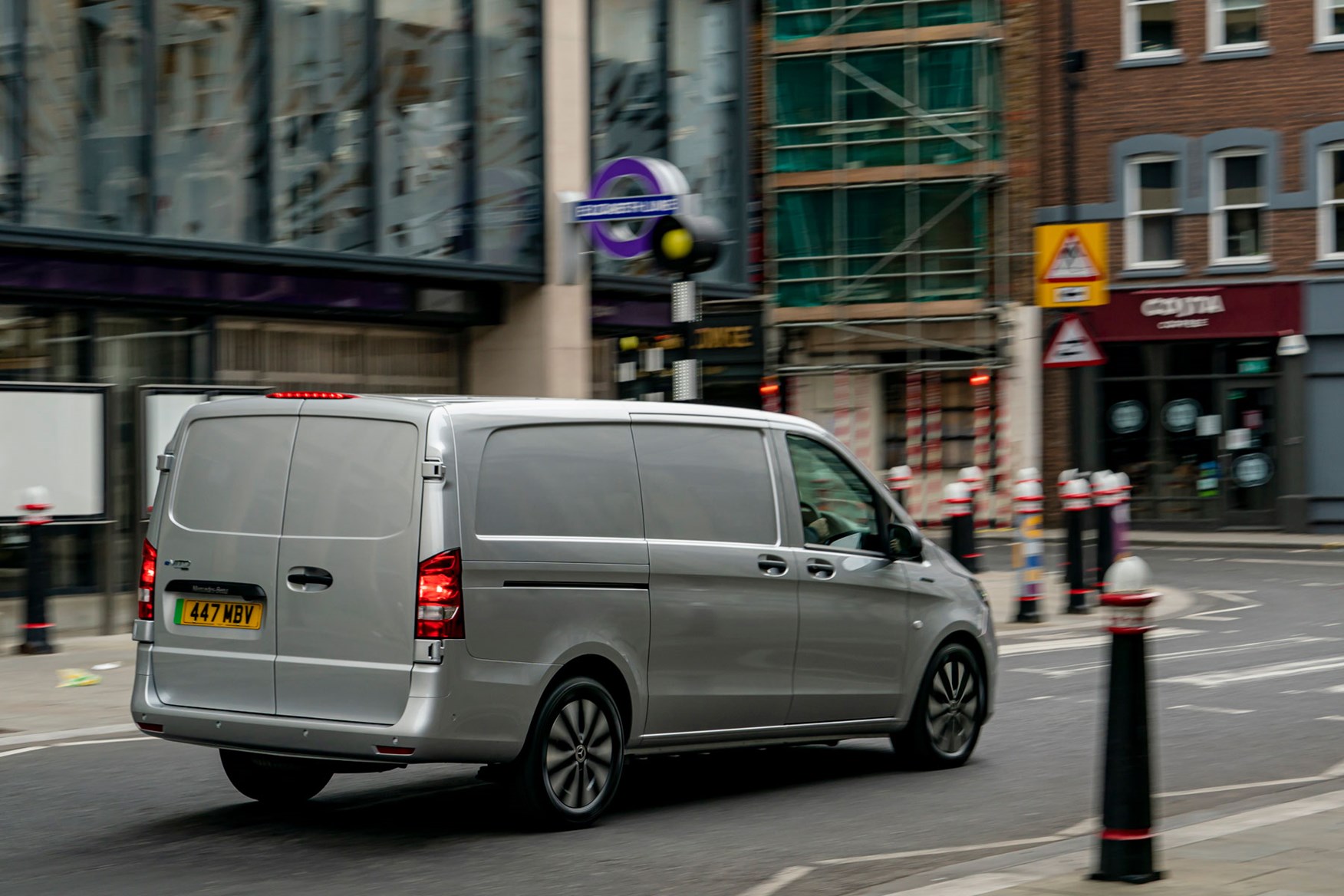
Mercedes says the eVito requires servicing 'once a year', but that’s on the understanding you probably aren’t going to do mega miles in one of these. If you do, you’ll need to visit your nearest Mercedes Van Centre more regularly, the same as with any other van.
Mercedes-Benz eVito warranty
The eVito has the same three-year, unlimited mileage warranty as all Mercedes vans.
The warranty for the electric drive battery pack, however, is eight years or 160,000km – that’s around 99,500 miles. This guarantees that the battery will still have 70% capacity at the end of this period. As with all lithium-ion batteries, performance does degrade over time, but we wouldn't expect there to be major issues until it's much more thoroughly used than that.
Mercedes-Benz eVito standard equipment
The eVito comes in two trim levels in the UK. Originally these were the Pure and Progressive models, but in November 2020 Mercedes changed things around a bit, dropping the entry-level Pure and adding a higher-specification Plus Package above Progressive.
As of 2022 this changed again, and now the two trims are Progressive and Premium.
These are the current standard equipment highlights at the time of writing (January 2023):
Mercedes-Benz eVito Progressive standard equipment highlights:
- Height and reach adjustable steering wheel
- Seven-inch Audio 30 infotainment screen with DAB, Apple CarPlay and Android Auto
- Reversing camera
- Air-conditioning
- Communications module for online services including Mercedes Pro Connect
- Heated driver’s seat with eight-way adjustment and lumbar support
- Dual passenger seat
- Twin side loading doors
- 11kW AC charging and 80kW DC charging
- Active brake assist with pedestrian detection
- Cruise control and hill start assist
- Speed limiter
Mercedes-Benz eVito Premium standard equipment highlights (in addition to Progressive):
- 75mph speed limiter
- Colour-coded bumpers
- Chrome grille
- Electrically folding door mirrors
- 17-inch alloy wheels
- Front and rear parking sensors
- Lumbar support for driver's seat
- Leather steering wheel
- Front fog lights
As highlighted when discussing the servicing costs above, there are fewer moving parts in an electric van, so theoretically fewer things to go wrong. You shouldn’t even use brake pads as fast if you make the most of the braking function built into the drive system.

The batteries are guaranteed to maintain 70% capacity for eight years or 62,000 miles. They’re also fitted in three packs that can be replaced individually, should they become damaged.
MobiloVan roadside assistance
All new Mercedes Vans come with MobiloVan roadside assistance, which is free for up to 30 years (!) as long as the van is serviced by a Mercedes dealer.
- Improved safety kit
- Lots more now standard
- Gold rating from Euro NCAP
The eVito was decidedly poor on the safety front when it was first launched but has made big strides since. The whole Vito range secured a Gold rating when it was crash tested by Euro NCAP in 2022 - one below the top rating but far better than many other vans.
Mercedes-Benz eVito safety equipment
Safety kit is now quite generous for a van, with all the following included as standard:
- Active brake assist
- Attention assist
- An acoustic warning to alert pedestrians to the eVito's presence
- Crosswind assist
- SOS alert
- Driver and passenger airbags (side and window airbags are optional)
Mercedes-Benz eVito security
As for security, all versions of the eVito are fitted with a CanTrack tracking module and are compatible with Mercedes Pro Connect - and you get a three-year subscription to this as part of the package.
This smartphone app can allow you to check the security status of the vehicle, lock it (and unlock it) remotely, find its location and geofence it so you get an alert if it travels out of (or into) a set area.
From the November 2020 upgrade, an alarm system is standard, too - though this was only available as an optional extra on earlier models.
Which Mercedes-Benz Vito eVito is best for me?
There really is only one choice with the eVito, and that is between the two trims, Progressive and Premium. The latter adds more visual upgrades, but you get all the things you need - the infotainment system, safety kit and fast charging - with the Progressive model.
With a sensible head on it makes more sense to go for the cheaper model. There is only about £3,300 in it though, and with prices starting at £43,600 this isn't a huge upgrade percentage wise.































